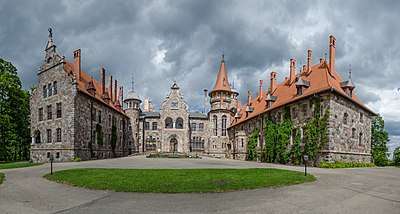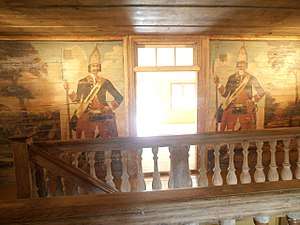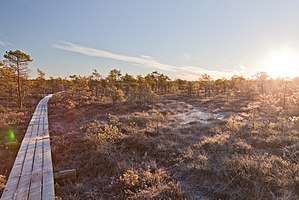Vidzeme
Destinations
Cities
- 🌍 Cēsis – One of the country's oldest towns. It has an impressive castle complex of Livonian Order origin, a charming city centre with some cobblestoned streets, and historic wooden buildings.
- 🌍 Ligatne – A village fairly well known for its nature trails, with a great natural park with wildlife animals and "fairy tale" forests with characters from famous Latvian fairy tales. Nearby, also an old Soviet bunker complex can be visited, which was built in case of a nuclear war.
- 🌍 Madona – A scenic town surrounded by hills, forests and lakes, and a winter sports centre.
- 🌍 Seda – Founded in 1953 in an uninhabited area, it still embodies the pomp of Communist and Stalinist shock-work aka architecture. Nearby a vast man-made peat bogs nature area can be found, and is not to be missed. Both occurrences are historically tied to each other.
- 🌍 Valmiera – Features the only professional theatre in the region, castle ruins, a medieval church, a famous brewery, and is the start of the Gauja National Park.
- 🌍 Alūksne – A summer holiday destination with Lake Alūksne, recreational activities and start/destination of the only narrow gauge railway in the Baltics
- 🌍 Gulbene – A small town with the only narrow gauge railway in the Baltics, to/from Alūksne.
- 🌍 Strenči – Features a mental hospital in a nice surrounding.
- 🌍 Valka – A unique town on the Estonian border, which runs through the town centre, creating Valga on the other side. It is close to regaining the status of an important cultural centre.
- 🌍 Smiltene – Features a manor, some castle ruins, and a watch tower over the surrounding area. Not very interesting, but quite cosy and slightly larger than Valka, and not far from the Pskov highway.
Other destinations
- 🌍 Cesvaine – A small town that is home to the eclectic 19th century Cesvaine Palace, and ruins of medieval castles. The oldest palace in the country, its magnificent landscapes of pine forests are cut by Gauja river.
- 🌍 Straupe – A large village, drawing its history from times, when somewhere in these region the largest fort of the Livonians existed. At the time of the Livonian Order, two castles were built in Straupe. Even though the city itself was part of the Hanseatic League, it was under the control of Riga, using it as an outpost for fighting the mighty Wenden. The wars of the second half of the 16th century completely destroyed Straupe. Later, it resurrected in the form of a village and apparently not quite where it was before.
National parks
- 🌍 Gauja National Park. Latvia's largest national park and one of the most famous natural attractions in Latvia with remarkable sandstone rocks and medieval castles, noblemen's estates and ancient churches of varying degrees of preservation, and the interesting and picturesque cities and towns of Sigulda, Ligatne and Cēsis. It is located to the northeast of Riga, where the Gauja River forms a deep valley with steep cliffs of sandstone. Along the river bank numerous caves and a beautiful mixed forest can be marvelled at. Also, the valley of Gauja is a wonderful opportunity to see small towns, rural life and nature of Latvia.
Understand
.jpg)
The main tourist attraction of this region is the Gauja National Park, which offers superb natural landscapes and several castles. The old town of Cēsis as well as its two castles have been totally restored – it is an unmissable destination of the region. Further south, the city of Madona is surrounded by numerous winter sports centres.
Talk
- Latvian is the official language of Latvia.
- English is the best option with youth as it is normally being taught as the first foreign language in the schools.
- Russian is widely spoken by mid-age and eldery people.
- People of northern areas (near Valka) may speak Estonian.
- German was taught in some schools during the Soviet times, some people may still speak it at a basic level.
Get in
1188.lv provides up-to-date bus and train schedules, route planner and prices.
By bus
Many bus routes exist in the region. Direct connections between Riga and all major cities and towns exist and departures are fairly frequent - usually once an hour.
Many buses in the region provide free WiFi access, especially on longer distance routes.
By train
There are some train routes going from Riga as far as Valga, in Estonia. The further the distance, the less frequent the connections. However, at least two trains a day go till Valga, connecting Cēsis, Valmiera, and Seda. There is an evening train to Madona on some days of the week.
By car
Getting into the region by car is fairly simple. In remote places of the region the road might be unsealed.
Get around
See

- 🌍
Cesvaine Palace (Adolf von Wolf Palace / Cesvaines Pils), Pils iela 1, Cesvaine, ☎ +371 64852225. Tu–Su 10:09–18:00. Enclosed by a romantic park and an ancient manor houses. The palace is considered one of the brightest architectural achievements of the 19th century. It is a masterpiece of eclectic art, which combines architecture, metallurgy, sculpture and painting.
The castle was built between 1893 and 1896. Since 1919, a school inhabited the castle. In 2002 a fire destroyed the castle roof. Thus, a new school was built in Cesvaine, and the castle gradually recovered its former appearance. Between 2003 and 2006 the left wing and a castle tower were restored, with restoration work continuing today.
The castle also inhabits a museum.
It is closed for renovation of the roof until end of 2018, but it should still allow for great pictures and a visit to the surrounding area.
- 🌍
Lielstraupe Castle, Straupe (Contrary to what the name might suggest, not situated in the Lielstraupe village but Straupe town.). One of the six medieval castles in the Gauja Valley. The most intact, but at the same time the most heavily reconstructed – from the distance it will look like some large modern country estate. The castle is believed to have been built in 1263, but its architect is unknown. In the fourteenth century Lielstraupe Castle became a vassal castle for the archbishop of Riga. During the second half of the 16th century, it was destroyed by numerous times and consequently rebuilt in the style of Baroque. The church adjacent to the castle is the only building that survived. It is is connected to the residency by a covered passage and stands out from yellow buildings with its white colour and rectangular shape. However, also the church was burned, collapsed, and then in the middle of the 18th century was converted from a three-nave into a one-nave version. In 1905, the castle again was burned, by rebellious peasants this time, and afterwards carefully restored in the former style of Baroque. During Soviet times, Narcological Hospital was moved into the castel, which still there to this day.
Check out the church behind the castle, and further behind it, a wooden bell tower from 1848. The bell tower was added later, when the church became a parish church. Before it was just part of the castle and did not need a bell. - 🌍 Mazstraupe Castle, Straupe. It was built about one hundred years later than Lielstraupe Castle. Otherwise history repeated itself here, just the major restructuring took place earlier, at the very end of the 18th century. The resulting palace was smaller and less impressive. Furthermore, in 1938 one of its parts was demolished due to the lack of money for repairing the roof. Nowadays, the palace is a school and not that interesting anymore.

- 🌍
Ungurmuiža Manor, Ungurmuiža, Raiskuma pagasts (15 km northwest from Cēsis), ☎ +371 22007332, e-mail: info@ungurmuiza.lv. May–Sep Tu–Sa 10:00–18:00, Su 10:00–16:00. A very small manor with its main attraction, a wooden baroque manor house from 1732. Of course, separately, there are more than enough wooden houses and baroque monuments all over Latvia. However, in combination, something like it can only be found here. As it was common in the 18th century, the house was painted in the style of Baroque. The paintings were done directly on the logs preserving their texture. Thus, parallels exist with the painted wooden house of Khvalynsk in Russia, and other very few monuments of the same style. The paintings are neither abstract nor primitive, but full of honesty. Besides a slant in serene Italian landscapes, they are absolutely anecdotally, like the portraits of Peter the Great in the form of a grenadier.
The paintings can only be visited when the museum is open. Access to the rest, the territory of the estate, is not restricted. In addition to the manor house, pay attention to the tea pavilion in the park, which resembles a wooden chapel from the side, the wooden granary (1738-40) and the tomb (1758-60). €3 (2014). - 🌍 Tirza Ski Museum, Ziedukalns, Tirza, ☎ +371 26954827, +371 25650809, e-mail: info@slepjumuzejs.lv. The museum presents an exhibition of ski equipment of the past, and additionally provides equipment for active recreation during the winter (skis, sticks, sledges) and during the summer (equipment for Nordic walking).
- 🌍 Museum of Emils Darzins, Jāņaskola, Jaunpiebalgas, ☎ +371 64162354, +371 64100351. Famous Latvian composer, who lived between 1875 and 1910.
Do
.jpg)

- 🌍 (Mount) Gaiziņkalns. The highest point of Latvia (311 m). But it is more famous for winter and summer recreation possibilities offered by numerous ski slopes, lake Kaķītis (rafting, fishing), the Lido recreation complex, etc.
- 🌍 Lake Lubānas (in the far southeastern corner of Vidzeme). The largest lake in Latvia by area, but also one of the shallowest ones with average depth of 3 m. A great place for windsurfing and under-ice fishing in winter.
- 🌍 Teiču Swamp Nature Reserve (Teiču dabas rezervāts) (in the far southeastern corner of Vidzeme). Take some of the wood-board walking paths to observe wild animals and birds. It is necessary to contact the reservoir's guide for entry permission.
- 🌍 Krustkalnu Nature Reserve (Krustkalnu dabas rezervāts) (located between Mārciena, Lazdona and Ļaudona). Rich in wildlife and forest-covered steep hills.
- 🌍 Underground Lakes (Vējiņu alas) (about 15 km north of Ligatne). Only possible with guide. Fun with kids but probably not that exciting for adults. €1.5-3.
Eat
Drink
Sleep
In the following a list of various accommodation options in the region worth mentioning and outside of the above covered cities, towns, and parks:
- 🌍 Daina Mezanci Brivdienu Maja, Страупе, Straupes pagasts, ☎ +371 26520523. From €10.
- 🌍 Green Camping, Daibes 1, Plāņu pagasts, Strenču novads, ☎ +371 20420295, e-mail: greencamping.lv@gmail.com.
- 🌍 Chill Up, Vecpiebalga, ☎ +371 22013324, e-mail: info@chillup.lv. Cosy, clean, quiet and cheap wooden rooms. Bed linen – all at your disposal. Hot shower and WC outdoors. Single from €10.
- Krāči, Burtnieku novads, ☎ +371 27886969 (Ilze), +371 26647065 (Juris), +371 29218371 (Kalvis). Situated on the banks of the Gauja river.
Go next
- Riga region – Starting or finishing point for most people coming to Latvia, and also home to numerous sights worth visiting, like Riga and its old city, the holiday and sea resort town of Jūrmala, Sigulda and its castles, as well as The Great Ķemeri Moorland.
- Latgale – A less touristy and more Russian influenced region, but with the amazing Basilica of the Assumption near Daugavpils.
- Zemgale – Flattest region in Latvia, and famous for the neighbouring and historically related Jelgava Palace and Rundāle Palace, near Jelgava and Bauska, respectively.
- South Estonia – From Valka a stone's throw away is Valga, the gateway to South Estonia, with the beautiful Sangaste Castle, the winter sports and nature centre Otepää, the Seto ethnicity in its far southeast, the intellectual hub and university town of Tartu, the picturesque and folk-focused Viljandi, as well as the centre of Estonian wine production, Põltsamaa. Hiking, skiing, fishing, clubbing, folk music, and beaches – South Estonia leaves nothing left to be desired.